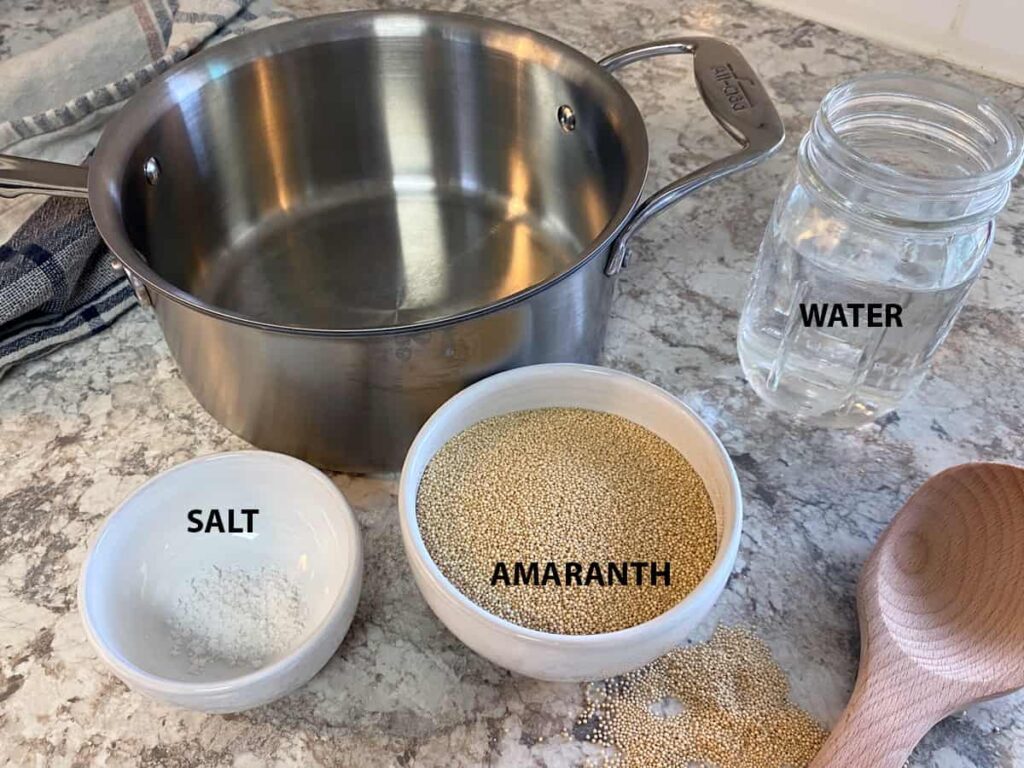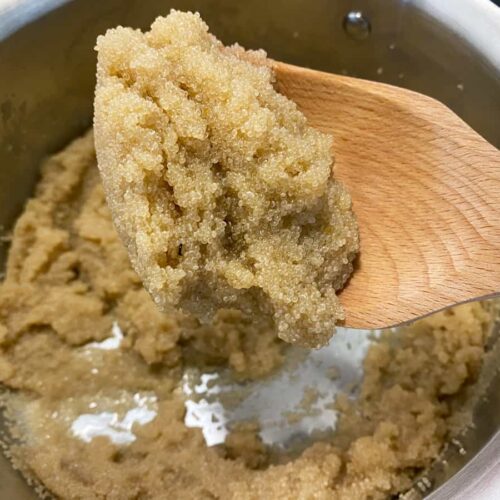Similar to quinoa and other ancient grains, amaranth is rich in fiber and protein, which is why I first wanted to try cooking with it. I was expecting it to cook similar to quinoa, also a seed, but it is a much stickier and wetter grain.
I want to share some of the tips and tricks, as well as my favorite recipes, of this grain.
What is amaranth?
Although amaranth is a member of the ancient grains family, it isn’t actually a grain. Amaranth is a pseudowheat (a seed used like wheat) that has been harvested for many thousands of years. An ancient grain because it was cultivated by the Aztecs and Incas who inhabited modern day Mexico, more and more people are getting introduced to it in food.
Amaranth is a seed, similar to quinoa and buckwheat. In fact, both quinoa and amaranth belong to the Amaranthaceae family.
Compared to other grains, amaranth is much smaller. It’s just a little larger than a poppy seed. You can prepare amaranth in a range of different ways (check out my favorites below).
As amaranth is gluten-free, it is ideal for all gluten-free diets and gluten-free products for both savory and sweet recipes. It is a complete protein that includes all 9 essential amino fatty acids, as well as fiber and antioxidants.
This seed is very popular in Indian and Asian cuisine, where it is typically called “ramdana” which means “God’s grain”.
What can amaranth be used for?
What has surprised me the most about amaranth is its versatility in cooking. It can be used for both sweet and savory recipes. It’s prized for the delicious flavor and texture it adds to cereal, side dishes, entrees, and baked goods.
Some of my favorites are:
- Mexican rice with amaranth: A staple at our house, as it can easily be combined with tacos, enchiladas, steak, eggs, or many other dishes. Adding amaranth adds a protein-punch to this go-to side dish
- Alegría: A Mexican candy made from seeds of amaranth and a sweetener (such as honey, sugar, or molasses), originating from the town of Santiago Tulyehualco in the Xochimilco borough of Mexico City, Mexico
- Popped amaranth: Can be a gluten-free or complete-protein snack, used as a breading (using it in place of bread crumbs when making chicken nuggets), sprinkled on yogurt or salads, or even as a crunchy topping to ice cream or fruit
How to cook amaranth
Thanks to its versatility, amaranth can be used in a range of different ways and dishes.
You can roast, pop or boil it, or you can even just add it to your dishes raw for a little extra crunch.
This makes it a fantastic alternative to quinoa, buckwheat, rice and some other popular grains that you should use for your favorite breakfast, lunch and dinner dishes.
Two ingredients to make amaranth

- Amaranth: Available at health food stores or online, you’ll want to get raw amaranth seeds that are cleaned and ready for cooking. It’s always a good idea to pick through any whole grains, looking for debris or rocks, before cooking
- Salt: I always cook with kosher mineral salt. You can use table salt, but use less than the recipe, adding more to taste
- Water: Tap water works great!

Stovetop amaranth pilaf (rice)
Equipment
- 1 Medium-size pot
Ingredients
- 1.5 cups water
- 1 cup amaranth
- 1/4 tsp salt or more to taste
Instructions
- Make sure your amaranth grains are clean and free of debris. Most amaranth purchased is already cleaned, but you want to make sure.
- Bring the water to a boil in a medium pot. Add salt.

- Add the amaranth grains to the boiling water.

- Reduce the heat to low, and simmer for about 20 minutes, or until the grains are tender and the water has been absorbed.

- Serve hot as a side dish or use it as a base for another dish. Note that amaranth will NOT have a texture similar to rice … it will be sticky and wet in appearance.

Other ways to cook amaranth
Instant pot
You can also cook amaranth a little bit faster when you use an instant pot.
- Add the amaranth, one and a half cups of water, and a quarter teaspoon of salt into the pot.
- Your instant pot should have a setting for “multigrain,” which is what we’ll use. Select this option and select the cooking time for 12 minutes.
- Let your amaranth depressurize on its own, waiting until the lock falls.
- Fluff with a fork and your grains should be ready to eat
Amaranth “oatmeal” cereal
This makes them ideal as a delicious breakfast cereal.
Use one and a half cups of the liquid of your choice (water, milk, or even apple juice) with half a cup of amaranth. (I prefer the creaminess of whole milk!) This will result in around one and a half cups of amaranth “oatmeal.”
- Put the liquid of your choice and amaranth in a small pot, then bring it to a boil
- Reduce the heat and leave the seeds to gently simmer without a lid on the pot
- The liquid should be fully absorbed after around 20 minutes. It’s a good idea to keep a close eye on the amaranth while cooking as it can quickly turn mushy towards the end if you leave it to sit for too long
- Serve immediately. Try some nuts, fruit, cinnamon, brown sugar, or other natural sweeteners, like honey
Popped amaranth seed “popcorn”
Another fantastic way to cook your amaranth seed is just by popping them, similar to popcorn.
- Add a tablespoon of uncooked amaranth into a dry, medium-high skillet. Be careful as the amaranth seeds will pop immediately!
- Continue moving the skillet until all the seeds are popped
- Serve immediately
Although these seeds are very small, then can double in volume when popped. However, they are still relatively small compared to, for example, popcorn.
Popped amaranth seeds are ideal to add to granola or on top of a salad for an extra crunch. They give your dishes a toasted flavor with some added texture.
Combine with other grains
If you love your grains, then you can also combine amaranth with other grains, such as buckwheat (find out what buckwheat tastes like here) or brown rice (check out my favorite way to eat amaranth, Mexican rice with amaranth).
As amaranth has a slightly nutty sweetness, and it will not only give your dish a more unique flavor, but will bump up the protein amount..
Simply use a ratio of three quarters cup other grains to one quarter cup of amaranth.
Thicken soups
Thanks to its gelatinous properties, amaranth is ideal for thickening stews and soups.
Just add a couple of tablespoons of the seeds to your soup about 20 minute before serving, and you will notice how it quickly thickens.
Use it in lieu (or in addition to) rice, add it as a compliment to soup with pasta, or in a vegetable soup.
How to store amaranth?
Like other grains, you should store amaranth in an airtight container in a cool and dry place.
The whole seeds can also be stored in the freezer for up to six months. We’d recommend storing the flour in the freezer as well (also up to six months).
If you notice a rancid smell (it will smell “off”) coming from the amaranth grains, then they have gone off and you should dispose of them.
Final thoughts
Amaranth is so versatile that you can use it in so many different ways, and a large range of dishes.
From your breakfast cereal to your side salad for dinner, amaranth is a great, gluten-free alternative to rice.








